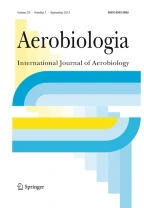Summary
It is no longer enough that aerobiologists identify pollen grains and fugal spores under the microscope. They are expected to serve as well allergologists, who want to known about the concentrations of various allergens in the air samples, as meteorologists, who need to know about the frequency of primary biological aerosols, which may act in radiative forcing of the atmosphere. Methods utilized by the aerobiologists vary from immunochemical analyses, culture and germination to infecting host plants with certain pathogens. Difficulties to separate between short, medium and long range transport of airborne particles on the basis of their viability are discussed.
Similar content being viewed by others
References
Brewbaker J.L., Kwack B.H. (1963) —The essential role of calcium ion in pollen germination and pollen tube growth. Am. J. Bot.,50:859–865.
Cook S.A., Stanley R.G., (1960) —Tetrazolium chloride as an indicator of pine pollen germinability. Silvae Genet.,9:134–136.
Edmonds R.L. (ed), (1979) —Aerobiology. The ecological system approach, US/IBP Synthesis Ser. 10.
Gregory P.H., (1973) —The microbiology of the atmosphere. Leonard Hill, Aylesbury.
Hirst J.M., Hurst G.W., (1967) —Long-distance spore transport. In: Airborne Microbes. 17th Symp. Soc. Gen. Microbiol. Imperial College, London, Apr. 1967, 307–344.
Hirst J.M., Stedman O.J., Hogg W.H., (1967 a) —Long-distance spore transport: methods of measurement, vertical spore profiles and the detection of immigrant spores. J. Gen. Microbiol.,48:329–355.
Hirst J.M., Stedman O.J., Hurst G.W., (1967 b) —Long-distance spore transport: vertical sections of spore clouds over the sea. J. Gen. Microbiol.,48:357–377.
Hjelmroos M., (1991) —Evidence of long-distance transport of Betulapollen. Grana,30:215–228.
Ho R.H., (1992) —Quantifying the effect of viability of contaminant pollen. In: Di Giovanni F., Joyce D. (eds.), Challenges in pollen dispersal and pollen contamination, Rep. CCAD-92-008:47–50.
Kauppinen E.I., Jäppinen A.V.K., Hillamo R.E., Rantio-Lehtimäki A.H., Koivikko A.S., (1989) —A static particle size selective bioaerosol sampler for the ambient atmosphere. J. Aerosol Sci.,20:829–838.
Koski V., (1970) —A study of pollen dispersal as a mechanism of gene flow in conifers. Comm. Inst. For. Fenn.,70:1–78.
Mandrioli P., Negrini M.G., Scarani C., Tampieri F., Trombetti F., (1980) —Mesoscale transport of Coryluspollen in winter atmosphere. Grana,19:227–233.
Mandrioli P., Negrini M.G., Cesari G., Morgan G., (1984) —Evidence for long range transport of biological and anthropogenic aerosol particles in the atmosphere. Grana,23:43–53.
Muilenberg M.L., (1989) —Aeroallergen assessment by microscopy and culture. Immunol. Allergy Clinics N. America,9:245–268.
Perkins W.A., Leighton P.A., (1957) —The rotorod sampler. 2nd Semi-annual Rep., No. CML 86. Aerosol Lab., Stanford University.
Pulkkinen P., Rantio-Lehtimäki A., Kemppainen I., (1993) —Artificial dispersal of foreign pollen into a Scots pine seed orchard. Grana,32:364–371.
Pulkkinen P., Rantio-Lehtimäki A. (1993) —Pine pollen viability and development of male flowering. Abstract. IUFRO Symposium, Aug. 22–26, Victoria, BC, Canada.
Rantio-Lehtimäki A., Viander M., Koivikko A., (1994) —Airborne birch pollen antigens in different particle sizes. Clin. Exp. Allergy,24:23–28.
Raynor G.S., Ogden E.C., Hayes J.V., (1973) —Variation in ragweed pollen concentration to a height of 108 meters. J. Allergy Clin. Immunol.,51:199–207.
Rubow K.L., Marple V.A., Olin J., McCawley M.A., (1987) —A personal cascade impactor: design, evaluation and calibration. Am. Ind. Hyg. Assoc. J.,48:532–538.
Schumacher M.J., Griffith R.D., O'Rourke M.K., (1988) —Recognition of pollen and other particulate aeroantigens by immunoblot microscopy. J. Allergy Clin. Immunol.,82:608–616.
Spieksma F. Th. M., Kramps J.A., Van der Linden A.C., Nikkels B.H., Plomp A., Koerten H.K., Dijkman J.H., (1990) —Evidence of grass-pollen allergenic activity in the smaller micronic atmospheric aerosol fraction. Clin. Exp. Allergy,20:273–280.
Stanley R.G., Linskens H.F., (1974) —Pollen: biology biochemistry and management. Springer Verlag, N.Y., pp. 307.
Tauber H., (1965) —Differential pollen dispersion and the interpretation of pollen diagrams. Geol. Survey Denmark, Ser. II No 89.
Trewartha G.T., Horn L.H., (1980) —An introduction to climate. McGraw-Hill, New York, pp. 416.
Author information
Authors and Affiliations
Rights and permissions
About this article
Cite this article
Rantio-Lehtimäki, A. Short, medium and long range transported airborne particles in viability and antigenicity analyses. Aerobiologia 10, 175–181 (1994). https://doi.org/10.1007/BF02459233
Issue Date:
DOI: https://doi.org/10.1007/BF02459233
